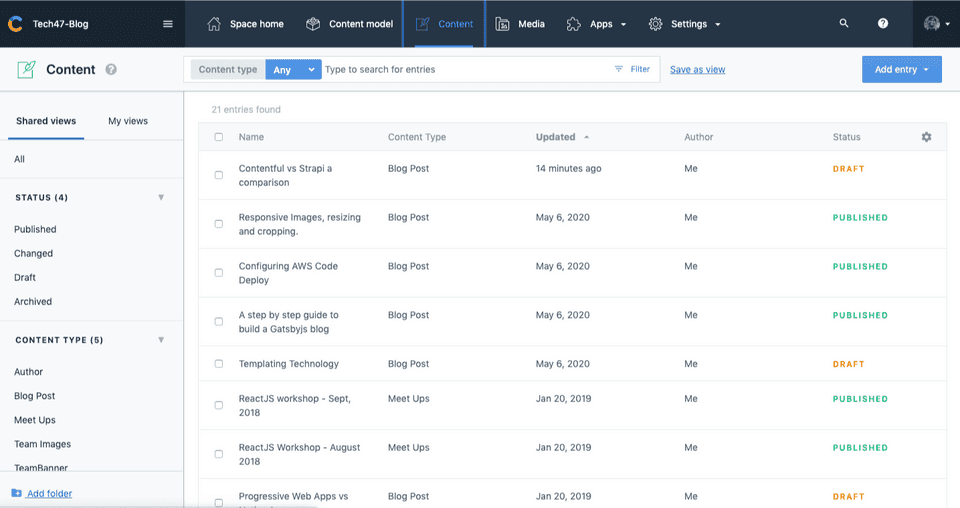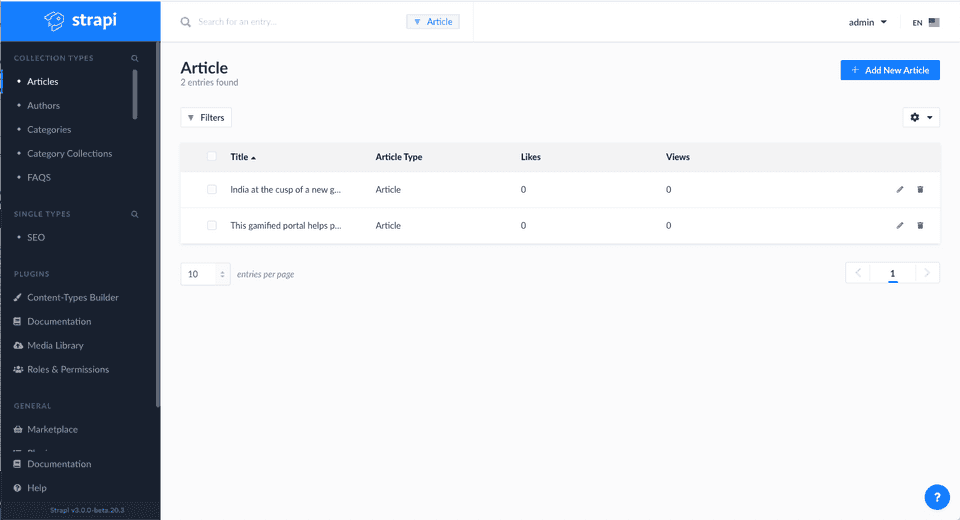Contentful vs Strapi a comparison
— — — —
I recommend Contentful as a CMS for media companies and Strapi for tech companies. Contentful is a complete solution ideal, for non technical users. Strapi is developer friendly..
— — — —
Headless CMS
A headless CMS, also known as a decoupled CMS, is a content management system (CMS) that is separated from the frontend of a web application or website. In a traditional CMS, the content is managed and stored in the backend, and the frontend is used to display the content to users. In a headless CMS, the backend and frontend are separated and the content is managed and delivered using APIs.
One of the key advantages of a headless CMS is that it allows for more flexibility and customization. Since the frontend and backend are decoupled, you can use any frontend technology you want to display the content, and you can use the APIs to access and manipulate the content as needed. This can make it easier to integrate the CMS with a wide range of applications and devices, and to deliver the content to multiple channels and platforms.
Another advantage of a headless CMS is that it can be more scalable and performant. Since the frontend and backend are separated, the frontend can be optimized for the specific needs of the application, and the backend can be scaled independently to handle the demands of managing and delivering the content.
Overall, a headless CMS can provide a number of benefits, but it may also require a more technical approach to setup and maintenance. Whether or not a headless CMS is the right choice for your project will depend on your specific needs and requirements.
Contentful
Contentful is a powerful headless cms. It comes loaded with features. It is an ideal CMS for publishing houses and large teams. It is hosted in the cloud and ready to be used.
Contentful has a markdown editor for rich text. The markdown editor of contentful has a few extra options like undo, redo, insert symbols, insert tables, indentation, code block.
Below are some of the features I liked in contentful
- Single sign on, Useful when we are building an app and already have an authentication system in place.
- Role based access, Useful to implement editorial flows. For different roles, like contributor, editor, publisher.
- Spaces, To power multiple portals from a single account.
- Strong ecosystem, E.g the contentful plugin in Gatsby is feature rich because of the number of users and contributors.
Is Contenful expensive?
Contentful is a subscription-based content management system (CMS), so the cost will depend on the plan you choose and the features you need. The pricing for Contentful is based on the number of entries and API calls you make, as well as the features and services you use.
Contentful offers a free plan that includes a limited number of entries and API calls, as well as basic features like content modeling and webhooks. This plan may be suitable for small, personal projects or for evaluating the platform.
For more advanced features and higher usage, Contentful offers paid plans. These plans include more entries, API calls, and features like localization, preview environments, and content validation. The exact cost will depend on your specific needs and usage.
Overall, Contentful is not the cheapest CMS on the market, but it offers a wide range of features and services that can be useful for managing and delivering content at scale. Whether or not it is expensive will depend on your specific needs and budget.
Contentful pricing plan is here
Strapi
Strapi is great for organisations who want to build a custom CMS solution while keeping control on their data. Strapi is an open source CMS, written in node.js and react.js. Strapi needs a server with minimum 2GB RAM. Strapi is free.
Strapi is highly configurable, everything can be configured - admin panel, database, api routes, models, controllers. It can use sql, postgres or nosql based db’s. This makes strapi great to roll out your own custom backend!
Strapi by default has a markdown editor for rich text. Strapi also gives the ability to replace the default editor, with your own WYSISWYG editor.
Strapi has an enterprise edition, which is not open source. The enterprise edition comes with features typically needed by large enterprises. Things like advanced Role-Based Access Control (RBAC) and Single Sign On (SSO)
The strapi codebase on github is here - Strapi github
When should you not use Strapi?
If you only have a small amount of static content that does not need to be frequently updated or managed, using a CMS like Strapi may be unnecessary. Additionally, if you are not comfortable with the technical aspects of setting up and maintaining a CMS, it may be better to use a simpler solution or to work with a developer who can help you manage the system.
Can we use Strapi as a backend?
Yes, Strapi can be used as a backend for your web application or website. Strapi is a content management system (CMS) that provides a flexible and customizable backend to store, manage, and organize your content. It can be used to create and manage a wide range of content types, including text, images, videos, and more.
One of the key features of Strapi is its API-first architecture, which allows you to access and manipulate your content using RESTful APIs. This means that you can use Strapi as the backend for your web application and use the APIs to retrieve and modify the content as needed. This can make it easier to integrate Strapi with your frontend application, whether it is built using a framework like React, Angular, or Vue.js, or using a static site generator like Gatsby or Next.js.
Overall, using Strapi as the backend for your web application can provide a number of benefits, including the ability to easily manage and organize your content, the flexibility to customize the backend to your needs, and the ability to access your content using APIs.
Which is better Strapi or Contentful?
It is difficult to say which is better Strapi or Contentful, as the suitability of a CMS for a particular project can depend on a number of factors. Both Strapi and Contentful are popular and widely-used CMS platforms that offer similar features, such as the ability to easily manage and organize content. However, there are some key differences between the two platforms.
One key difference between Strapi and Contentful is the way they are structured. Strapi is an open-source CMS that can be installed and run on your own server, while Contentful is a cloud-based CMS that is hosted by the company. This means that with Strapi, you have more control over the infrastructure and can customize it to your needs, but you also have to manage and maintain the server yourself. With Contentful, you do not have to worry about managing the infrastructure, but you have less control over the system.
Another important difference is the pricing model. Strapi is free to use, but you may have to pay for hosting and other services if you do not run the CMS on your own server. Contentful, on the other hand, has a subscription-based pricing model, where you pay based on the number of entries and API calls you make.
Ultimately, which CMS is better for you will depend on your specific needs and preferences. It may be worth considering both Strapi and Contentful and evaluating which one is a better fit for your project.
Where to use Contentful?
I would recommend Contentful as a great CMS for media companies. Contentful comes with a rich set of features ready to be used by non technical folks.
Where to use Strapi?
Strapi is developer friendly and would work well with technical teams. So, I would recommend Strapi for tech companies who need flexibility and customizations in their CMS systems. Strapi needs a dedicated tech team to install, customize and manage.

